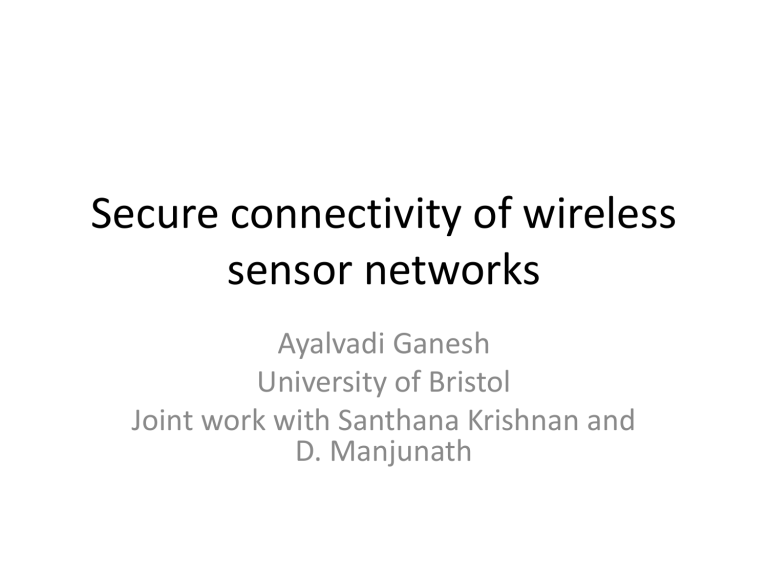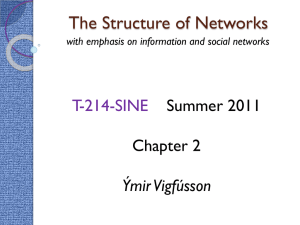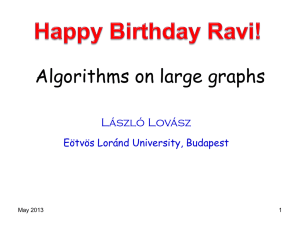20130816133014151

Secure connectivity of wireless sensor networks
Ayalvadi Ganesh
University of Bristol
Joint work with Santhana Krishnan and
D. Manjunath
Problem statement
• N nodes uniformly distributed on unit square
• Pool of P cryptographic keys
• Each node is assigned K keys at random
• Two nodes can communicate if they are within distance r of each other and share a key
Q : For what values of N, K, P and r is the communication graph fully connected?
Background: Random key graphs
Eschenauer and Gligor (2002): Key distribution scheme for wireless sensor networks
Yagan and Makowski (2012): Analysis of the full visibility case
Theorem : Suppose P=
(N). Let K 2 /P = (log N+
N
Then, P(connected)
1 if
N and P(connected)
0 if
N
+
)/N
Heuristic explanation
• Probability of an edge between two nodes is approximately K 2 /P
• Mean degree of a node is approximately
NK 2 /P = log N +
N
• Edges are not independent but, if they were:
– key graph would be an Erdos-Renyi random graph
– has connectivity threshold at mean node degree of log N
Background: Random geometric graphs
• N nodes uniformly distributed on unit square
• Edge probability g(x/r
N
) for node pairs at distance x from each other
• Boolean model: g(x) = 1(x<1)
Penrose: Let
Nr
N
2 = log N +
N
P(connected)
1 if
N
, and
0 if
N
Generalisations
• Mao and Anderson:
– Similar model but with Poisson process of nodes on infinite plane.
– Same scaling of r
N
– Under suitable conditions on g, show a threshold between having isolated nodes in unit square, and no components of finite order in unit square
Results for geometric key graphs
•
• Mean node degree
r 2 K 2 /P
• If
r 2 K 2 /P = log N + c , then
P(graph is disconnected) > e
c /4
• If
r 2 K 2 /P = c log N and c>1 , then
P(graph is connected)
1
Upper bound on connection probability
• Graph is disconnected if there is an isolated node
P(node j is isolated)
(1
r 2 K 2 /P) N
exp(
r 2 NK 2 /P)
e
c /N
• Bonferroni inequality:
P(there is an isolated node) ≥
i
P(i is isolated)
i<j
P(i and j are isolated)
Isolation of pairs of nodes
Lower bound on connection probability
• Approach for ER graphs
– Compute probability that there is a connected component of m nodes isolated from other n
m
– Take union bound over all ways of choosing m nodes out of n , and over all m between 1 and n/2
Approach for geometric key graphs
• Tesselate unit square with overlapping squares of side r/
2
Approach for geometric key graphs
• Are there disconnected components of different sizes in the unit square?
• Are there “locally” disconnected components of different sizes within the small squares of side r/
2 , considering only nodes within that square?
Big picture of proof
• There are no small – size O(1) – components in the unit square disconnected from rest
• There are no large – size > 6 – locally disconnected components in any small square
• Can also bound the number of nodes in small components within a small square : very few of them
• So how might the graph be disconnected?
Notation
• N : number of nodes in unit square
• r : communication radius of a node
• P : size of key pool
• K : number of keys assigned to each node
• n=
r 2 N : expected number of nodes within communication range
• p=K 2 /P: approximate probability that two nodes share a key
Assumptions
• N,K,P
, K 2 /P
0
• nK 2 /P
c log N for some c>1
• K > 2 log N
• Corollary:
– Number of nodes in each small square is
(log N)
– concentrates near its mean value of n/(2
)
– uniformly over all squares
Within a small square
• n/(2
) nodes, full visibility
• Mean degree is nK 2 /(2
P) = c/(2
) log N
• Even if edges were independent, expect to see local components of size up to 2
, somewhere in the unit square
Show there are no bigger components, taking edge dependence into account
Within a small square
• Say there is a connected component of size m isolated from the rest
• Say these m nodes have mK
j keys between them
• Then
– j ≥ m
1
– None of the other n
m nodes in the square has one of these mK
j keys
Number of keys among
m
nodes
• Assign K distinct keys to first node
• Assign subsequent keys randomly with replacement
• P(collision at (i+1) th step)
i/P , independent of the past
• P(j collisions)
P(≥j collisions)
?
Collision probability bounds
• X
1
, X
2
, … , X n variables independent Bernoulli random
• X i
~ Bern(p i
)
• Y = X
1
+…+X n
• Z is Poisson with the same mean as Y
• Hoeffding (1956): Z dominates Y in the convex stochastic order
Within the big square
• Say nodes 1,2,…,m form a connected component isolated from the rest. Then
– for some permutation of 1,2,…,m there is an edge between each node and the next
– they hold mK
j keys between them, for some j
– there is no edge between the remaining N
m nodes and these m
Putting the pieces together
• Most nodes belong to a giant component
• Each small square may contain some nodes that are locally isolated or within small components
• These must either be connected to the giant component in a neighbouring cell, or to another small component
• Latter is unlikely, doesn’t percolate









